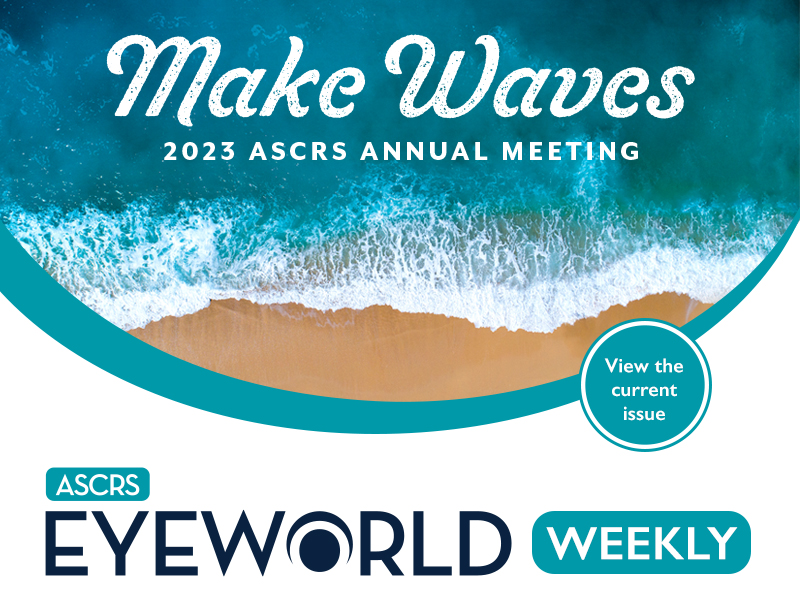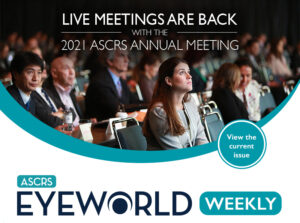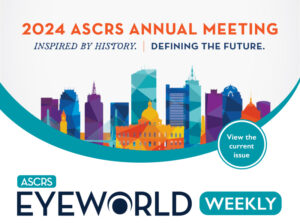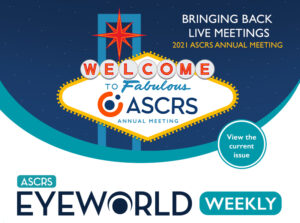
- Researchers discover new class of drugs that could treat retinal dystrophies
- Enrollment complete in Phase 1/2a study using novel dry eye treatment approach
- NDA submitted to FDA for investigational inflammation and pain treatment
- Study: first-in-human gene therapy trial for achromatopsia
- ASCRS news and events
May 19, 2023 • Volume 29, Number 20
Researchers discover new class of drugs that could treat retinal dystrophies
Researchers at the University of California, Irvine, discovered a new class of small-molecule drugs that could have applications for treating AMD, diabetic retinopathy, and retinitis pigmentosa. According to the university’s press release, their discovery shows that “stress resilience-enhancing drugs” are able to slow or stop the development and progression of certain retinopathies, preserving structure and function, in genetic and environmental animal models. This research is published in the Proceedings of the National Academy of Sciences.
Enrollment complete in Phase 1/2a study using novel dry eye treatment approach
Invirsa announced that it has completed enrollment in its Phase 1/2a study to determine safety and preliminary efficacy of INV-102 as a topical treatment for moderate dry eye. According to the company’s press release, INV-102 uses a novel approach to treating dry eye; it is a small molecule that activates the pathways for the protein p53 and Pax6, accelerating DNA repair and cellular stabilization. The company stated that in this first clinical trial, INV-102 was well tolerated, safe, and reduced signs and symptoms of dry eye. Topline data from the Phase 1/2a study is expected in the third quarter of this year.
NDA submitted to FDA for investigational inflammation and pain treatment
Formosa Pharmaceuticals and AimMax Therapeutics submitted an NDA to the FDA for APP13007, which the company’s press release describes as a nanosuspension of clobetasol propionate (0.05%) for treatment of inflammation and pain following ocular surgery. According to the company, APP13007 was evaluated in two pivotal Phase 3 trials against placebo. One drop twice daily for 14 days met primary endpoints of sustained clearance of ocular inflammation and pain relief, with statistical and clinical superiority over placebo, according to the company. The safety profile was similar to placebo.
Study: first-in-human gene therapy trial for achromatopsia
A prospective Phase 1/2, open-label, non-randomized clinical trial was conducted to assess safety and efficacy of an AAV-based gene therapy to treat CNGB3-associated achromatopsia. The study, published in the American Journal of Ophthalmology, described the research that enrolled 23 adults and children with this form of achromatopsia. According to the paper, adults were given one of 3 doses (up to 0. 5 mL). The authors wrote that after a maximum-tolerated dose was established for adults (n=11), an expansion phase was conducted for pediatric participants (3 years and older, n=11). The authors reported that ocular inflammation occurred in nine participants and was, for the most part, mild to moderate. Topical and systemic steroids were effective for resolving inflammation. The authors reported “favorable” changes for individual participants in terms of efficacy, such as color vision for six participants, improvements in photoaversion in 11 patients, and improved vision-related quality of life questionnaire scores in 21 patients. The authors concluded that this treatment has an acceptable safety and tolerability profile, supporting further development and continued investigation.
ASCRS news and events
- ASCRS Summer Meeting: The ASCRS Summer Meeting in Nashville, Tennessee, returns August 11–13. Early bird registration pricing is ongoing through June 26.
- Cataract Awareness Month: Coming up in June ASCRS will recognize Cataract Awareness Month. Follow ASCRS on social media to keep up with the latest on this important awareness effort.
Research highlights
- A retrospective study published in the Journal of Cataract & Refractive Surgery sought to determine axial length and average keratometry changes over time, evaluating whether it’s necessary to repeat biometry when performing second-eye cataract surgery 6 months or more after the first eye. The patients included in the analysis were older than 35 years and had two biometry measurements more than 5 months apart. Data from patients with intraocular surgery other than cataract were excluded. The research included 201 patients (402 eyes) with an average age of 73.3. The average time between biometry measurements was 21.5 months. Mean change in axial length was 0.04 mm and mean change in K was 0.01 D. The authors concluded that these parameters did not change significantly over time, and repeating biometry for elderly patients receiving a monofocal implant may be of limited benefit.
- A randomized clinical trial published in the journal JAMA Ophthalmology compared swab pressing (a newer technique) to stromal hydration for sealing incisions and preventing anterior chamber collapse after phacoemulsification cataract surgery. The swab pressing technique, the authors wrote, uses a cotton swab to seal the clear corneal incision immediately. According to the paper, the trial included 126 participants who were randomly assigned to receive swab pressing or stromal hydration by a single, experienced surgeon between February 2022 and September 2022 at the Zhongshan Ophthalmic Center in China. The researchers found swab pressing to be noninferior to stromal hydration in sealing the clear corneal incisions; there was no difference between the two groups in terms of proportion of closed incisions and central anterior chamber depth at postop hour 1 and postop day 1. The authors suggest future studies evaluate if this technique prevents intraoperative transient collapse of the anterior chamber and its impact on visual acuity outcomes.
Product news
- Cassini launched Cassini Connect as a digital cataract surgery suite that is compatible with most leading microscope brands, allowing integration with preop diagnostics, digital ocular registration, and marking.
This issue of EyeWorld Weekly was edited by Stacy Jablonski, Liz Hillman, and Ellen Stodola.
EyeWorld Weekly (ISSN 1089-0319), a digital publication of the American Society of Cataract and Refractive Surgery (ASCRS), is published every Friday, distributed by email, and posted live on Friday.
Medical Editors: Sumit “Sam” Garg, MD, Chief Medical Editor, Mitchell Weikert, MD, Cataract Editor, Karolinne Rocha, MD, PhD, Refractive Editor, Julie Schallhorn, MD, Cornea Editor, Manjool Shah, MD, Glaucoma Editor
For sponsorship opportunities or membership information, contact: ASCRS • 12587 Fair Lakes Circle • Suite 348 • Fairfax, VA 22033 • Phone: 703-591-2220 • Fax: 703-591-0614 • Email: ascrs@ascrs.org
Mention of products or services in EyeWorld Weekly does not constitute an endorsement by ASCRS.
Click here to view our Legal Notice.
Copyright 2023, EyeWorld News Service. All rights reserved.



